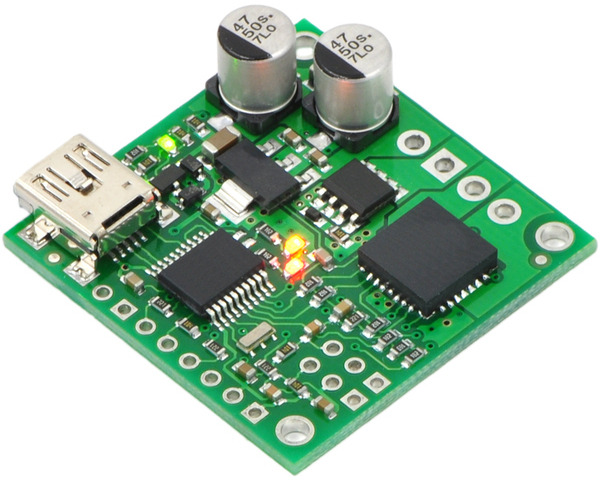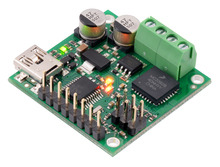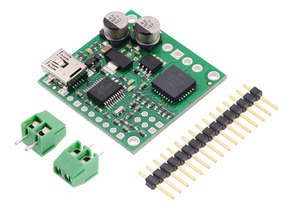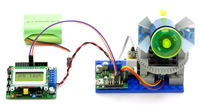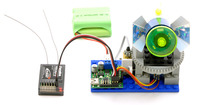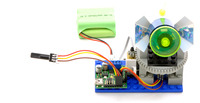Motion Control Modules » Brushed DC Motor Controllers » Pololu Jrk Motor Controllers with Feedback »
Jrk 21v3 USB Motor Controller with Feedback
The Jrk 21v3 motor controller is a highly configurable brushed DC motor controller that supports four interface modes: USB, logic-level serial, analog voltage, and hobby radio control (RC). The controller can be used with feedback for closed-loop speed or position control, or it can be used without feedback as an open-loop speed control. The continuous output current is approximately 3 A in the recommended operating range of 8 V to 28 V, with derated performance down to 5 V and transient protection to 40 V. This version ships with connectors included but not soldered in, allowing for custom installations.
Alternatives available with variations in these parameter(s): version Select variant…
 Compare all products in Pololu Jrk Motor Controllers with Feedback.
Compare all products in Pololu Jrk Motor Controllers with Feedback.
| Description | Specs (16) | Pictures (23) | Resources (11) | FAQs (2) | On the blog (4) | Distributors (15) |
|---|
Not recommended for new designs: We strongly recommend our newer and better (and smaller) Jrk G2 21v3 USB Motor Controller with Feedback over this controller, as it offers increased power and many other improvements at a lower price. We are continuing to offer the original Jrk 21v3 for now as a legacy product for those with systems designed specifically for this controller.
Overview
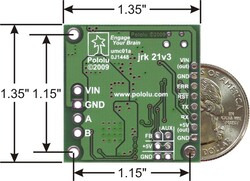 |
The Jrk 21v3 is a versatile, general-purpose motor controller that supports a variety of interfaces, including USB. The broad operating range from 5 V to 28 V and continuous output current of 3 A (5 A peak) allow this board to control most small DC brushed motors. Analog voltage and tachometer (frequency) feedback options allow quick implementation of closed-loop servo systems, and a free configuration utility (for Windows) allows easy calibration and configuration through the USB port. A USB A to mini-B cable (not included) is required to connect this controller to a computer.
Key improvements over competing products and earlier Pololu motor controllers with feedback include:
- USB connectivity with emulated serial (COM) port allows direct motor control from a PC.
- Ultrasonic PWM to eliminate switching-induced motor shaft hum or whine.
- Robust, high-speed communication protocol with user-configurable error condition response.
- High internal resolution (12 bits) for smooth and flexible calibration to various input and feedback devices.
- Current sensing and limiting.
- Reversed power protection.
- Field-upgradeable firmware.
The table below lists the members of the Jrk family, including the original (green) and newer G2 (black) versions, and shows the key differences among them.
 Jrk 21v3 |
 Jrk G2 21v3 |
 Jrk G2 18v19 |
 Jrk G2 24v13 |
 Jrk G2 18v27 |
 Jrk G2 24v21 |
|
|---|---|---|---|---|---|---|
| Recommended max operating voltage: |
28 V(1) | 28 V(1) | 24 V(2) | 34 V(3) | 24 V(2) | 34 V(3) |
| Max nominal battery voltage: |
24 V | 24 V | 18 V | 28 V | 18 V | 28 V |
| Max continuous current (no additional cooling): |
2.5 A* | 2.6 A | 19 A | 13 A | 27 A | 21 A |
| USB, TTL serial, Analog, RC control: |
 |
 |
 |
 |
 |
 |
| I²C control: |  |
 |
 |
 |
 |
|
| Hardware current limiting: |  |
 |
 |
 |
||
| Dimensions: | 1.35″ × 1.35″ | 1.0″ × 1.2″ | 1.4″ × 1.2″ | 1.7″ × 1.2″ | ||
| Price: | $74.95 | $54.95 | $109.95 | $109.95 | $149.95 | $149.95 |
| 1 Transient operation (< 500 ms) up to 40 V. 2 30 V absolute max. 3 40 V absolute max. * Reduced from “3 A” based on newer, more stringent tests. The value now is directly comparable to the rating for the newer G2 21v3. |
||||||
Main Features of the Jrk 21v3
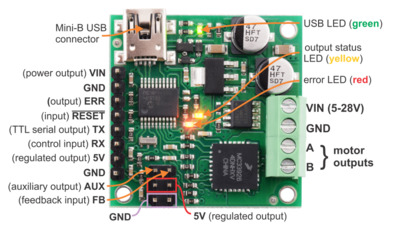 |
- Simple bidirectional control of one DC brush motor.
- 5 V to 28 V operating supply range.
- 3 A maximum continuous current output (5 A peak).
- Four communication or control options:
- USB interface for direct connection to a PC.
- Full-duplex, TTL-level asynchronous serial interface for direct connection to microcontrollers or other embedded controllers.
- Hobby radio control (RC) pulse width interface for direct connection to an RC receiver or RC servo controller.
- 0 V to 5 V analog voltage interface for direct connection to potentiometers and analog joysticks.
- Two closed-loop feedback options:
- 0 V to 5 V analog voltage.
- Frequency/tachometer digital input up to 2 MHz with 1 ms PID period.
(Open-loop control with no feedback also available.)
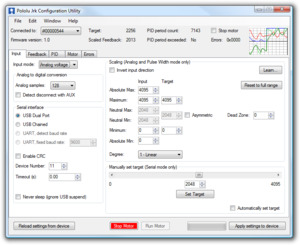 |
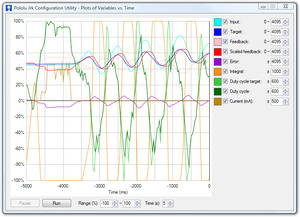 |
- Simple configuration and calibration over USB with free configuration program for Windows.
- Configurable parameters include:
- PID period and PID constants (feedback tuning parameters).
- Maximum current.
- Maximum duty cycle.
- Maximum acceleration.
- Error response.
- Input calibration (learning) for analog and RC control.
- Optional CRC error detection eliminates communication errors caused by noise or software faults.
- Reversed power protection.
- Field-upgradeable firmware.
- Optional feedback potentiometer disconnect detection.
- Comprehensive user’s guide.
Specifications
| Motor channels: | 1 |
|---|---|
| Operating voltage: | 5 V to 28 V |
| Continuous output current: | 3 A |
| Peak output current: | 5 A |
| Auto-detect baud rate range: | 300 bps to 115,200 bps |
| Available fixed baud rates: | 300 bps to 115,200 bps |
| Available PWM frequencies: | 20 kHz, 5 kHz |
| Reverse voltage protection?: | Yes |
| USB connector style: | USB Mini-B |
The Jrk 21v3 is the smaller of two Jrk motor controllers. For a higher-power version, see the Jrk 12v12.
Included Hardware
|
|
The Jrk 21v3 is available in two versions: “fully assembled” with terminal blocks and 0.1″ male header pins pre-installed (left picture above), and connector-free (right picture above). The connector-free version includes a straight 0.1″ breakaway male header strip and two 3.5mm, 2-pin terminal blocks, but these parts are not soldered to the board, which allows for custom installations.
The three mounting holes are intended for use with #2 screws (not included).
Example Feedback System – 4 Methods of Control
|
|
||||
|
|
